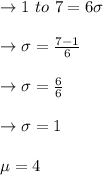Answer:
Follows are the solution to this question:
Explanation:
Given that:
n=1000
Where the data is distorted and the bad outlier is just axed,when we transform scores of its distribution form into z-score, that become negative or skewed to the left. If n=1000 doesn't have normal skewed knowledge, then:
The data range is between 1 to 7

In point (1):
The score that matches:

In point (2):
Its value of Z= 0.5 is

